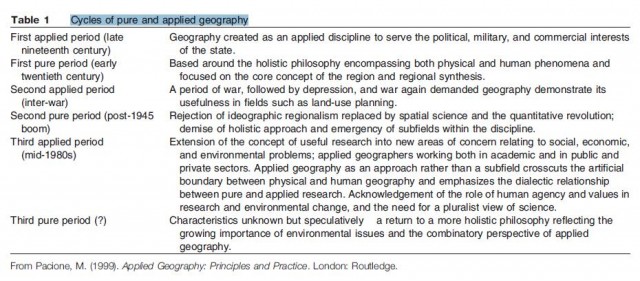The Relationship between Pure and Applied Research
Applied research in any discipline is best understood in contrast with basic, or pure, research. For some commentators basic research in geography aims to develop new theory and methods that help explain the processes through which the spatial organization of physical or human environments evolves. In contrast, applied research uses existing geographic theory or techniques to understand and solve specific empirical problems.
While this distinction is useful at a general level it overplays the notion of a dichotomy between pure and applied geography, which are more correctly seen as two sides of the same coin. There is, in fact, a dialectic relationship between the two. Applied geography uses the principles and methods of pure geography but is different in that it analyzes and evaluates real world action and planning and seeks to implement and manipulate environmental and spatial realities. In the process, it contributes to, as well as utilizes, general geography through the revelation of new relationships. The conjuncture between pure and applied research is illustrated clearly in geomorphology where, for example, attempts to address problems of shoreline management have contributed to theories of beach transport, the difficulties of road construction in the arctic have informed theories of permafrost behavior, while problems encountered in tunneling have aided the development of subsidence theory. Applied research provides the opportunity to use theories and methods in the ultimate proving ground of the real world, as well as enabling researchers to contribute to the resolution of real world problems. More generally, theory is essential in applied geography at two levels. First, it provides the framework for asking questions about the substantive relationships embodied in a problem (e.g., here a model of a hydrological catchment illuminates the potential effects of a proposed flood prevention scheme). Second, social theory provides a normative standard against which current and future social conditions may be judged in terms of defined moral goals (which may address issues such as whether a minimum wage and basic standard of living should be a legal entitlement in advanced capitalist societies).
There is little merit in pursuing a false dichotomy between pure and applied research. A more useful distinction is that which recognizes the different levels of involvement of researchers at each stage of the research and specifically the greater engagement of applied geographers in the 'downstream' or postanalysis stages. The applied researcher has a greater interest than the pure researcher in taking the investigation beyond analysis into the realms of application of results and monitoring the effects of proposed strategies. Researcher participation in the implementation stage may range from recommendations in scholarly publications or contracted reports (a route favored by most academic applied geographers, though not exclusively) to active involvement in implementation (more usually by applied geographers employed outside academia). Between these positions lie a variety of degrees of engagement, including acting as expert witnesses at public enquiries, dissemination of research findings via the media, field involvement in, for example, landscape conservation projects, and monitoring the effects of policies and strategies enacted by governmental and private sector agencies.
The balance between pure and applied research within a discipline varies over time in relation to the prevailing sociopolitical environment. When external pressures are at their greatest disciplines will tend to emphasize their problem solving capacity while during periods of national economic expansion 'more academic' activity may be pursued in comfort. Some have equated these cycles with the long waves of the world economy, and identified three periods in which applied geography was in the ascendancy (in the late nineteenth-century, inter war era, and mid 1980s), separated by two periods of pure geography (in the early twentieth century, and during the post 1945 economic boom) (Table 1).
